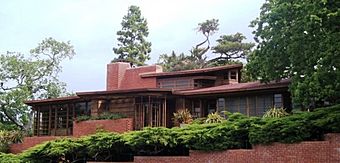Hanna–Honeycomb House facts for kids
|
Hanna-Honeycomb House
|
|

Frank Lloyd Wright's Hanna House
|
|
| Nearest city | Stanford, California, United States |
|---|---|
| Built | 1937 |
| Architect | Frank Lloyd Wright |
| NRHP reference No. | 78000780 |
Quick facts for kids Significant dates |
|
| Added to NRHP | November 7, 1978 |
| Designated NHL | June 29, 1989 |
The Hanna–Honeycomb House, also known as the Hanna House, is a special building on the Stanford University campus in Stanford, California. It was designed by the famous architect Frank Lloyd Wright. This house was his first project in the Bay Area and was unique because it used shapes other than just rectangles.
The American Institute of Architects chose it as one of Wright's most important buildings. It became a National Historic Landmark in 1989.
Contents
A House Like a Honeycomb
This amazing house was started in 1937 and grew over 25 years. It's the first and best example of Wright's clever hexagonal design. Imagine a honeycomb made by bees – that's what the house looks like! It's a "Usonian" home, which was Wright's idea for affordable, modern houses.
The house is about 3,570 square feet. It uses six-sided shapes with 120-degree angles everywhere. You can see these shapes in its floor plan, its many tiled terraces, and even in the built-in furniture. There are no straight 90-degree corners in the entire house!
The Hanna-Honeycomb House was designed for Paul R. Hanna and his wife Jean. They were both well-known teachers at Stanford University. They started the project when they were a young couple with three children. So, the home had four bedrooms and three bathrooms. Over time, the house was made bigger and changed with Wright's help as the Hannas' family and work needs changed.
Building and Repairing the House
Building the house was not easy. Wright's first plans were for flat land, but the Hannas bought a hilly lot. The cost also went up a lot. The original plan was $15,000, but it ended up costing over $37,000.
Also, Mr. Hanna found out that his land was partly on the San Andreas Fault. This is a major earthquake fault line. Wright, whose Imperial Hotel had survived a big earthquake in Japan, was not worried.
Sadly, the house was badly damaged by the 1989 Loma Prieta Earthquake in 1989. Even though that part of the fault was quiet during the quake, the house's base and chimney were not strong enough. They might have fallen if the earthquake had lasted longer. A big 10-year repair project finished in 1999. This time, the house was made much stronger to handle earthquakes.
What Makes the House Special
The house is one story tall. It has a central clerestory, which is a high wall with windows that lets in light. It's built with local redwood wood, San Jose brick, concrete, and large plate glass windows.
The house fits perfectly into the hillside where it was built. The floors and courtyards follow the natural slope of the land. The whole property is about one and a half acres. It includes the main house, a guesthouse, a hobby shop, a storage building, a double carport, a breezeway, and a garden house with pools and a waterfall.
After living in the house for 38 years, the Hannas gave the property to Stanford University in 1974.
How the House is Used Today
Today, Stanford University owns the Hanna House. You can visit it by making a reservation for a tour. The university also uses it for special events, like meetings and parties.
Images for kids
![]() This article incorporates public domain material from websites or documents of the National Park Service.
This article incorporates public domain material from websites or documents of the National Park Service.












